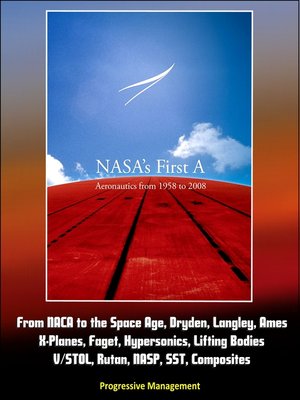NASA's First A
ebook ∣ Aeronautics from 1958 to 2008--From NACA to the Space Age, Dryden, Langley, Ames, X-Planes, Faget, Hypersonics, Lifting Bodies, V/STOL, Rutan, NASP, SST, Composites
By Progressive Management

Sign up to save your library
With an OverDrive account, you can save your favorite libraries for at-a-glance information about availability. Find out more about OverDrive accounts.
Find this title in Libby, the library reading app by OverDrive.



Search for a digital library with this title
Title found at these libraries:
| Loading... |
This is a comprehensive history of NASA's aviation programs, starting with NACA research in the 1940s and 1950s through the space race to current times. Topics covered include: NACA, Langley, Ames Research Center, Moffett Field, wind tunnels, von Karman, Hap Arnold, Jimmy Doolittle, Hugh Dryden, Max Faget, X-15, hypersonic research, X-20 DynaSoar, X-33, lifting bodies, digital fly-by-wire, V/STOL, STOL, VTOL, the Illiac computer, Advanced turbo prop, HiMAT, X-29, icing and wind shear safety issues, composites, Rutan, the blended wing body, scramjet, National Aerospace Plane (NASP), SST, and the Next Generation Air Transportation system.
That NASA is more than a space agency may come as a surprise to some. Aeronautics, the first A of the NASA acronym, has always been a part of the National Aeronautics and Space Administration, but against the headline exploits of rocket launches, Moon landings, Space Shuttle missions, and Mars rovers, aeronautics is easily lost in the shadows of NASA's marquee space programs. This relative obscurity belies what has been a remarkably creative, productive, and highly effective group of researchers who, at one time, even helped bring about the Space Age and invent a space agency. The list of accomplishments for NASA's first A is long, and this book goes a modest way toward sketching these developments.
Aeronautics really might be called the "other NASA," distinct in its charge, methodologies, and scale. Aeronautics research is not mission-oriented in the same way that going to the Moon or Mars is. It is interested in learning about physical phenomena, such as turbulence, and how to do something, such as quieting the noise of helicopter blades. Aeronautics' mission is not about going somewhere specific or building one particular thing; it is about supporting the country's commercial and military needs with respect to aviation. The contrast with the space program is telling: where NASA has gone to considerable lengths to justify the space program and explain how space innovations feed into the country's more terrestrial needs, aeronautics research has had a direct and undeniable impact on commercial and military technology development. Its positive economic effects are generally accepted.
Being research-oriented, aeronautics naturally has a different methodological bent. Its activities revolve almost entirely around experimentation, made up of a combination of cutting-edge basic research and more routine assistance to its patrons in the military and industry. It has encompassed the use of wind tunnels, the flight testing of revolutionary prototypes, and the creation of new methodologies, such as computational fluid dynamics. Finally, aeronautics research typically has been conducted on a small scale and on, relatively speaking, limited budgets. It has not been characterized by extremely large projects on the order of the Apollo or Space Shuttle programs. This is not for lack of desire within the aeronautical research community; rather, the political will to do in aeronautics what was done for the space program has not been similar. Ultimately, the bulk of aeronautics work has been performed on a fraction of NASA's overall budget. Even so, NASA's aeronautics has had an outsize impact.






